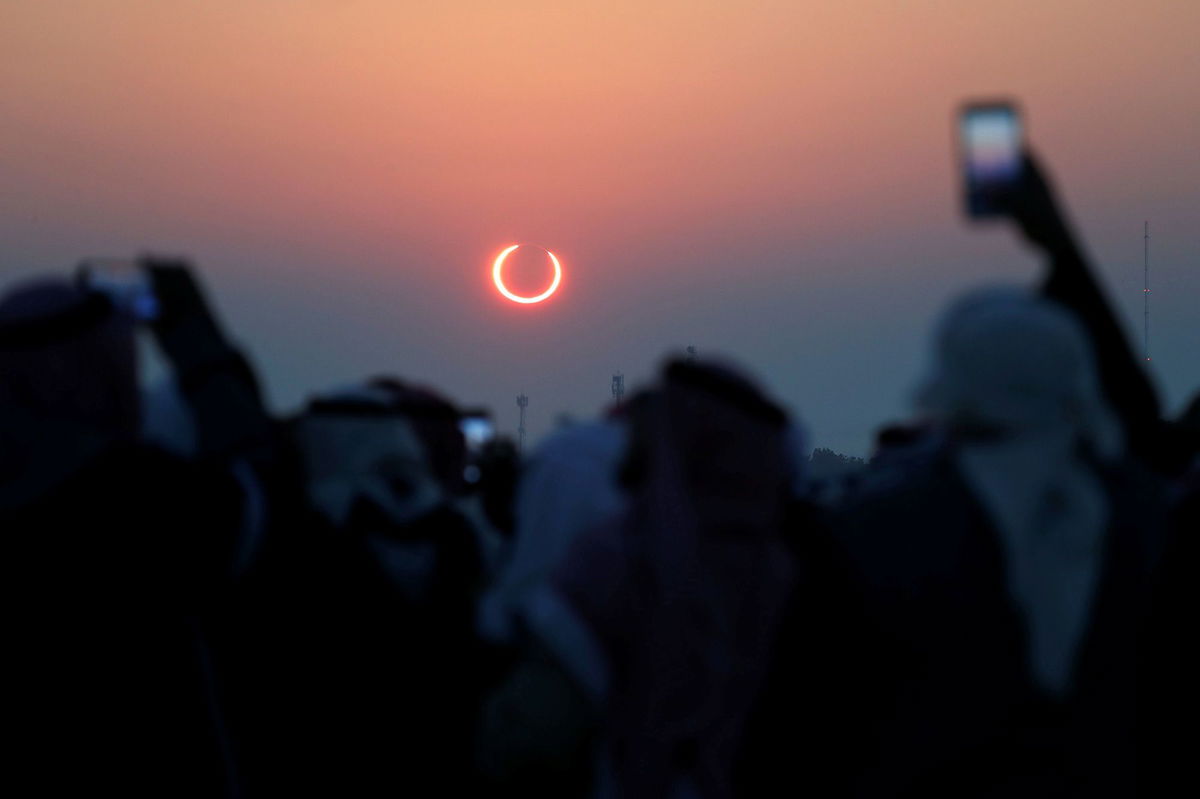A ‘ring of fire’ will soon appear in the skies over some parts of the world

By Ashley Strickland, CNN
(CNN) — A solar eclipse event will create a “ring of fire” in the skies over parts of South America on Wednesday, according to NASA.
Annular solar eclipses occur when the moon passes between Earth and the sun when the moon is near or at the farthest point in its orbit from Earth, so it can’t completely block the sun as it does during a total solar eclipse. Instead, the sun’s fiery light surrounds the moon’s shadow, creating the so-called ring of fire.
The path of Wednesday’s annular eclipse event will track over the Pacific and Atlantic oceans and Antarctica, but those in the remote southeastern Pacific territory of Rapa Nui, also known as Easter Island, and parts of Argentina and Chile should be able to see the ring of fire phenomenon if skies are clear.
Meanwhile, a crescent-shaped partial solar eclipse will be visible in Hawaii, American Samoa, Brazil, Fiji, French Polynesia, Mexico, New Zealand, the Pitcairn Islands, Kiribati, Tonga, Uruguay, South Georgia, the Falkland Islands and many other locations. To see whether the partial eclipse will be visible in your area, check Time and Date’s website.
If you’re in the path of the partial or annular eclipse and plan to observe either celestial spectacle, make sure you have a pair of certified eclipse glasses or a handheld solar viewer. The sun’s harmful rays will never be completely out of view, and watching these events could damage your eyes if you look directly at the sun.
The eclipse path
The annular eclipse is set to begin at 12:50 p.m. ET and end at 4:39 p.m. ET, according to Time and Date.
The path will start about 1,056 miles (1,700 kilometers) southwest of Hawaii, then move southwest, according to EarthSky. The eclipse is expected to peak, meaning the obscuring of the sun by the moon’s shadow will be at its greatest, at 2:45 p.m. ET over the ocean for just over 7 minutes.
But the eclipse will still put on a show for sky-gazers on land. The annular eclipse will first be visible overland in the remote island of Rapa Nui, famous for the hundreds of head-shaped statues found across the island, at 3:07 p.m. ET, and the ring of fire will have a duration of 6 minutes and 23 seconds, according to EarthSky.
Then, the eclipse will reach Chile’s Patagonian coast at 4:22 p.m. ET before it appears in the Andes and becomes visible in Argentina a couple minutes later and then the South Atlantic Coast at 4:27 p.m. ET.
Finally, a partial eclipse will be visible north of the Falkland Islands and South Georgia at 4:36 p.m. ET.
How to safely watch the eclipse
It’s never safe to look directly at the sun without using specialized protection, so there is no phase of an annular eclipse that is safe to view with the naked eye because the sun’s light is never completely blocked.
If you don’t have certified eclipse glasses or use a handheld solar viewer to observe the annular eclipse, you can use a telescope, binoculars or camera that has a special solar filter on the front, which acts the same way eclipse glasses would. But don’t look through any optical device — cameras lens, telescope, binoculars — while wearing eclipse glasses or using a handheld solar viewer, according to NASA. Solar rays can still burn through the filter on the glasses or viewer, given how concentrated they can be through an optical device, and can cause severe eye damage.
Sunglasses won’t work in place of eclipse glasses or solar viewers, which are thousands of times darker and held to an international standard. Don’t use torn, scratched or damaged eclipse glasses or solar viewers.
Eclipses can also be viewed indirectly using a pinhole projector such as a hole punched through an index card. These do-it-yourself viewers work if you stand with your back to the sun and hold up the card. The pinhole projects an image of the sun on the ground or other surfaces. But never face the sun and look directly at it through the pinhole.
Other pinhole projectors you may already have on hand include colanders, straw hats or anything with small holes in it. Or you can simply hold up your hands, space out your fingers and cross them over each other to create a waffle pattern. The small space between will reflect the sun’s crescent during a partial eclipse or a ring during the annular eclipse.
Standing by a leafy tree? The small spaces between leaves will dapple patterns of the eclipse phase on the ground.
If you’re sitting outside for a while awaiting the eclipse, don’t forget to apply sunscreen and wear a hat to protect your skin.
Upcoming celestial events
The next full lunar event, the hunter’s moon occurring on October 17, will be a supermoon and the closest of the year at 222,095 miles (357,428 kilometers) away.
The beaver moon will occur on November 15, and the final full moon of the year will be the cold moon on December 15.
Meanwhile, sky-gazers can anticipate a busy meteor shower season to close out 2024. Here are peak dates for upcoming celestial activity, according to the American Meteor Society:
Draconids: October 7-8
Orionids: October 20-21
Southern Taurids: November 4-5
Northern Taurids: November 11-12
Leonids: November 17-18
Geminids: December 13-14
Ursids: December 21-22
The-CNN-Wire
™ & © 2024 Cable News Network, Inc., a Warner Bros. Discovery Company. All rights reserved.


